

A More Sustainable Holiday Season with Furoshiki Wrapping Cloth
Summary
Reflection Questions
Journal Prompt
The holiday season—traditionally a period of heightened consumer activity—carries a substantial environmental footprint. Much of this comes from the waste generated by wrapping and packaging materials. As global awareness of environmental conservation escalates, the adoption of sustainable practices during this festive period becomes increasingly imperative. In this context, the Japanese tradition of Furoshiki—a reusable wrapping cloth—emerges as an ecologically responsible alternative to disposable paper. This ancient practice—dating back to the Nara period—not only epitomizes the art of cloth wrapping for carrying and gift presentation but also reflects a heritage deeply rooted in sustainability and resourcefulness. This article examines the viability of Furoshiki as a sustainable option for gift wrapping—considering its historical significance and potential to mitigate the environmental impacts of holiday celebrations.
Understanding Furoshiki
Furoshiki refers to a traditional Japanese wrapping cloth used to carry bento boxes, clothes, gifts, or other goods. Historically, its usage is traced back to the Nara period—initially employed by the public to protect valuable goods.
Over time, Furoshiki evolved into a versatile tool for daily transport and an elegant medium for gift presentation. The term itself is derived from ‘furo’, meaning bath, and ‘shiki’, which means spread—alluding to its use in public bathhouses to wrap clothing. Use of this fabric has since evolved beyond its “bath spread” meaning.
Both scrap fabric and stunning silk fabrics are now used for wrapping books, wine bottles, and other holiday gifts.
Materials Used to Make Furoshiki Cloth
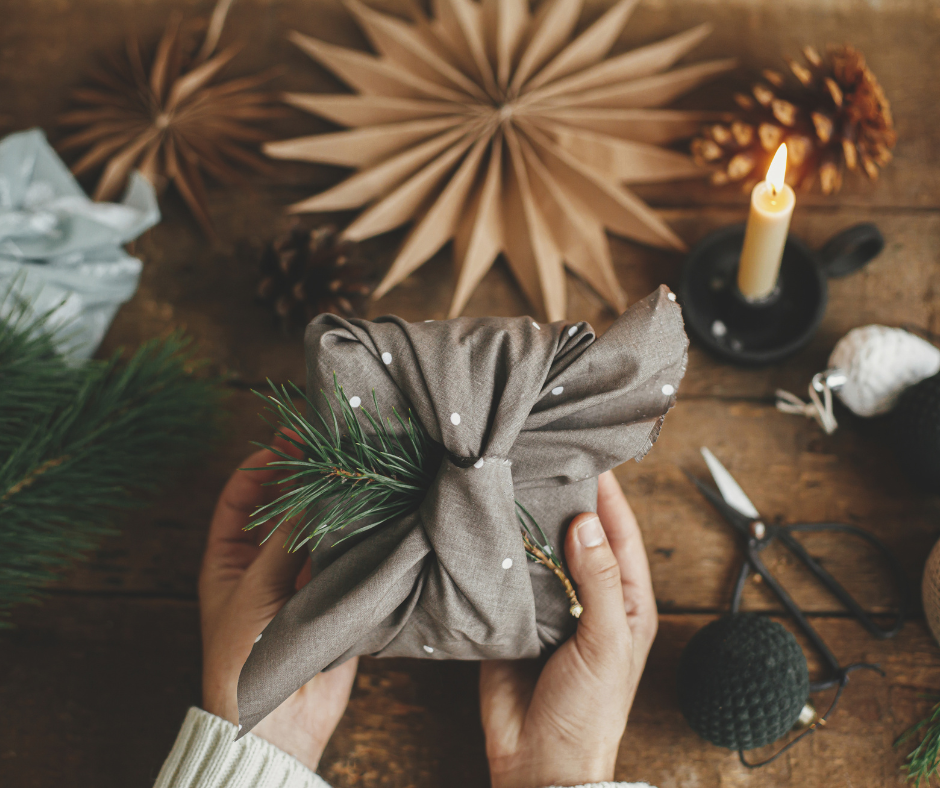

The fabric used in Furoshiki is varied—ranging from silk and cotton to modern synthetic fibers. The choice of material often depends on the intended use—silk for elegant gift wrapping, cotton for its durability and ease of maintenance, and synthetic fibers for resistance to weather and wear. Some are made specifically to wrap gifts, while others are crafted from unused fabric.
The cloths come in diverse sizes—with small squares suitable for wrapping modest gifts and larger ones designed for carrying objects such as bottles or even clothing. Their dimensions and inherent flexibility enable the wrapping of items in various shapes and sizes—a trait that pre-cut paper simply cannot match.
Versatility and Sustainability of Furoshiki Gift Wrap


In contrast to traditional wrapping paper, Furoshiki presents a sustainable and reusable option. Wrapping paper—often adorned with inks, laminates, and dyes—becomes a single-use item that contributes to the millions of tons of waste accumulated during the holiday season.
Furoshiki gift wrapping—conversely—can be employed countless times, adapted to different contexts, and even serve as part of the gift itself. This reusability factor—combined with the aesthetic value and historical significance of Furoshiki—positions it as a preferable alternative from both an environmental and cultural standpoint.
The Environmental Impact of Wrapping Paper


The environmental ramifications of wrapping paper are significant—particularly during the holiday season. Millions of pounds of gift wrap are discarded each year—a substantial portion of which occurs after holiday celebrations. This single-use product contributes voluminously to municipal solid waste streams, often peaking during post-holiday periods.
Environmental Cost of Paper Production and Disposal


The production of wrapping paper is resource-intensive—involving the consumption of wood pulp, water, and energy, accompanied by the emission of greenhouse gases and the generation of wastewater. The environmental toll extends beyond the manufacturing process to include the distribution and disposal stages—where the carbon footprint is exacerbated by transportation emissions and the energy consumption related to waste management practices.
Additionally, wrapping paper is frequently infused with metallic inks, laminates, and non-paper additives that render it non-recyclable—thus escalating its environmental impact when it ultimately resides in landfills.
Recycling Issues with Traditional Gift Wrap


Recycling issues are a significant challenge with traditional wrapping paper. Many recycling facilities are unable to process wrapping paper due to the aforementioned treatments, along with the presence of tape and other non-paper materials. Consequently, a substantial quantity of wrapping paper is diverted to landfills where it contributes to the generation of methane—a potent greenhouse gas—as it decomposes.
Long-Term Environmental Benefits of Using Furoshiki Cloth


Adopting Furoshiki as a gift-wrapping alternative presents numerous long-term environmental benefits. As a reusable option, Furoshiki circumvents the continuous production, consumption, and disposal cycle associated with traditional wrapping paper. By diminishing demand for single-use wrapping materials, Furoshiki usage can reduce waste generation and the depletion of resources required for paper production.
Furthermore, the transition towards such sustainable practices fosters a circular economy ethos—encouraging the reuse and repurposing of materials, which is pivotal in the collective effort to mitigate environmental degradation.
The Art of Furoshiki Wrapping


The art of Furoshiki wrapping is defined by a series of traditional techniques and folds that enable the transformation of a simple cloth into a secure and aesthetically pleasing gift wrap. Basic folds involve the precise placement of the gift at the center of the cloth, followed by a series of knotting and tucking actions that eliminate the need for adhesive materials.
The two opposite corners of the cloth are brought together and tied in a square knot—ensuring the contents remain enveloped within the fabric’s embrace. Mastery of these fundamental folds can lead to more complex arrangements—accommodating various shapes and sizes of objects.
Tutorials on Furoshiki wrapping often differentiate between objects of regular geometry—such as boxes, and those that are irregular, like bottles or round items. For example, a box might be wrapped using the “Otsukai Tsutsumi” fold, where the cloth is folded diagonally to create a triangle, and the item is placed in the center.
The corners are then folded over the item and tied on the opposite side. In contrast, wrapping a bottle might utilize the “Bin Tsutsumi” technique—where the bottle is rolled diagonally in the cloth, and the ends are pulled up and tied, creating a handle in the process.
Tips for Securing the Furoshiki Cloth without Tape
To secure the cloth without tape, the quality of the knots is paramount. A square knot, or reef knot, is sufficient for most Furoshiki wrappings, as it holds securely and is easy to untie. If you want to wrap clothes or other lightweight items, these knots should suffice.
For heavier items, a double knot may be employed for added security. The resilience and texture of the Furoshiki cloth itself also play a crucial role, as they provide friction that aids in maintaining the integrity of the knots.
How to Incorporate Decorative Elements in Your Furoshiki Gift Wrapping
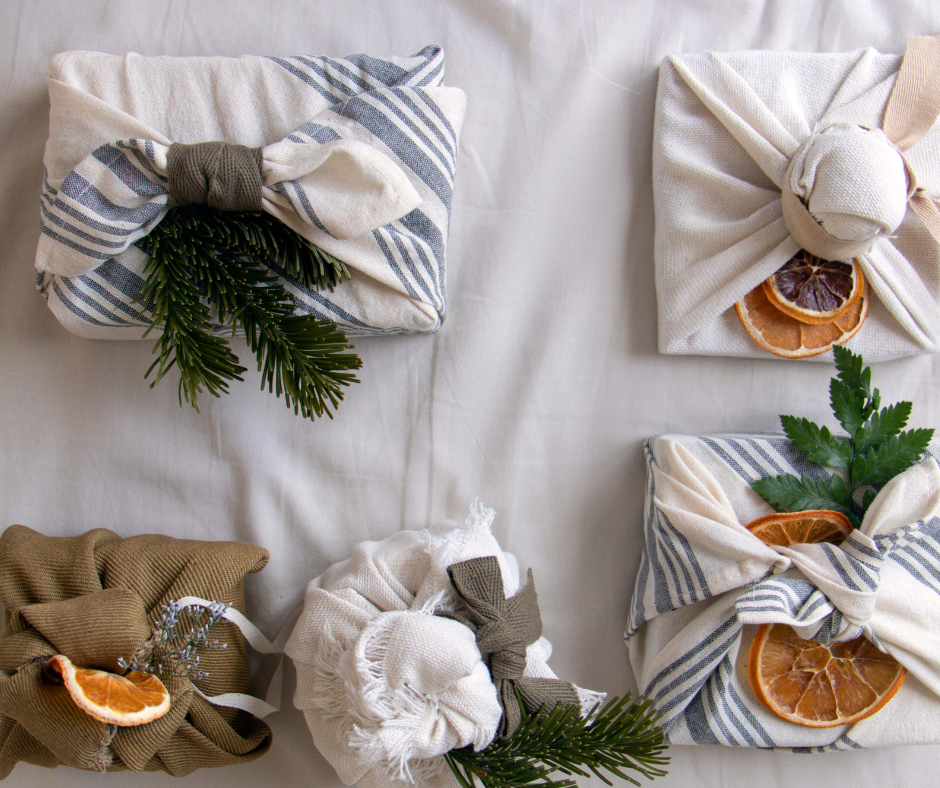

Incorporating decorative elements into Furoshiki gift wrapping elevates the presentation of the gift. The cloth itself can be selected for its aesthetic features—including traditional Japanese patterns, seasonal designs, or festive colors.
Additionally, natural embellishments such as sprigs of holly, cinnamon sticks, or dried orange slices can be tucked into the knots for a touch of elegance. Fabric accessories like brooches or wooden tags can also be attached to the knots—serving both as decoration and as a keepsake for the recipient.
Through these embellishments, Furoshiki not only serves as a sustainable wrapping choice but also becomes a canvas for personal expression and creativity.
Advantages of Furoshiki Beyond Sustainability
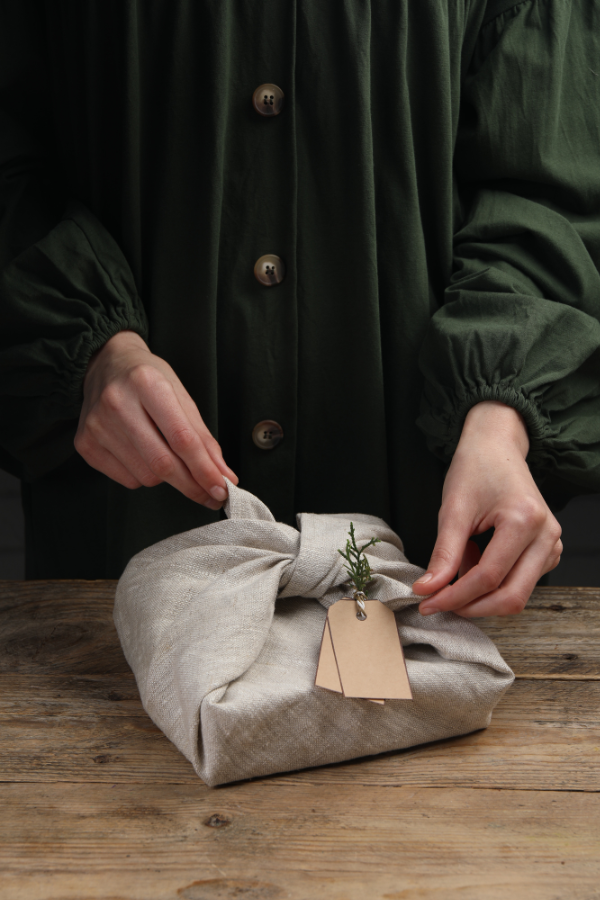

Furoshiki—while championed primarily for its sustainability—offers advantages that extend into the realms of aesthetics, culture, and utility. The cloth itself often bears designs ranging from traditional Japanese motifs to contemporary artistic expressions, which can be chosen to reflect the gift-giver’s personal style or to complement the occasion.
In the past, these cloths bore family crests and other special symbols unique the gift-giver. Today, wrappers can either purchase cloths with patterns such as these, or create their own through embroidery, printing, or stamping. The result of your custom spread is a visually striking package that stands out for its elegance and uniqueness—contributing to the aesthetic value of the gift.
Cultural Significance and Educational Aspect
Beyond mere decoration, Furoshiki carries with it a wealth of cultural significance. It is an emblem of a time-honored practice that encapsulates the Japanese ethos of ‘mottainai’—a sense of regret concerning waste—which resonates with contemporary efforts to live more sustainably.
Using Furoshiki can thus serve an educational purpose about Japanese culture while promoting environmental awareness. By adopting Furoshiki, gift-givers participate in a cultural exchange that broadens understanding and appreciation of sustainable living practices across borders.
Reusability for Various Purposes Beyond Gift Wrapping
The reusability of Furoshiki transcends gift wrapping. The cloths can be repurposed for a variety of functions: as tablecloths, scarves, or even as bags for carrying everyday items. This multifunctionality not only underscores the practicality of the Furoshiki but also its role in reducing the need for single-use or purpose-specific goods. By integrating Furoshiki into daily life, users can significantly diminish their ecological footprint.
Adding a Personal Touch to Gift Wrapping


Furthermore, the Furoshiki technique offers a personal touch in the act of gift-giving. The effort to select, fold, and tie a Furoshiki around a present is a deliberate and thoughtful process. It imbues the gift with a sense of care and consideration that pre-packaged or store-wrapped gifts may lack.
This personal connection—facilitated by the intimate act of wrapping by hand—fosters a deeper sense of connection between the giver and the recipient—emphasizing the personal relationship over the material value of the gift itself.
Implementing Furoshiki in Your Holiday Traditions


Incorporating Furoshiki into holiday traditions begins with a basic understanding of its methods and the procurement of suitable materials. Initiating the practice requires familiarization with fundamental Furoshiki techniques—often accessible through instructional literature or online tutorials that detail the folds and knots integral to this craft. Aspiring practitioners are encouraged to start with simple shapes and materials, advancing to more intricate designs as their proficiency improves.
Ideas for Sourcing Furoshiki Cloths


When it comes to sourcing Furoshiki cloths, one may consider a variety of avenues. Specialized retailers and online marketplaces offer a range of cloths—ensuring a selection that caters to diverse aesthetic preferences and functional requirements.
Artisans and craft fairs may provide handcrafted options—offering a touch of uniqueness. Importantly, the chosen cloths should be square and made of a fabric that is both sturdy and flexible so you can tie Furoshiki fairly easily.
For a more personalized and sustainable alternative, creating your own Furoshiki cloths from old fabric is an excellent option. Upcycling materials such as discarded garments, bed linens, tea towels, or unused curtains can breathe new life into otherwise forgotten textiles.
This not only reduces waste but also allows for the customization of size and embellishment—tailoring the cloth to specific gifting needs while embedding the cloth with a narrative quality.
Involving Family and Friends in the Tradition
Engaging family and friends in the Furoshiki tradition can transform this sustainable practice into a communal learning experience. Workshops or crafting sessions provide opportunities for collective creativity and skill-sharing—fostering a sense of community and shared purpose.
Gifting items wrapped in Furoshiki can also serve as a conversation starter—spreading awareness of this eco-friendly practice and perhaps inspiring others to adopt it in their gift-giving customs. As each person embraces Furoshiki, the tradition weaves its way into the fabric of the holiday experience—enriching it with environmental consciousness and cultural depth.
Will You Replace Paper Wrapping with Your Own Furoshiki This Season?
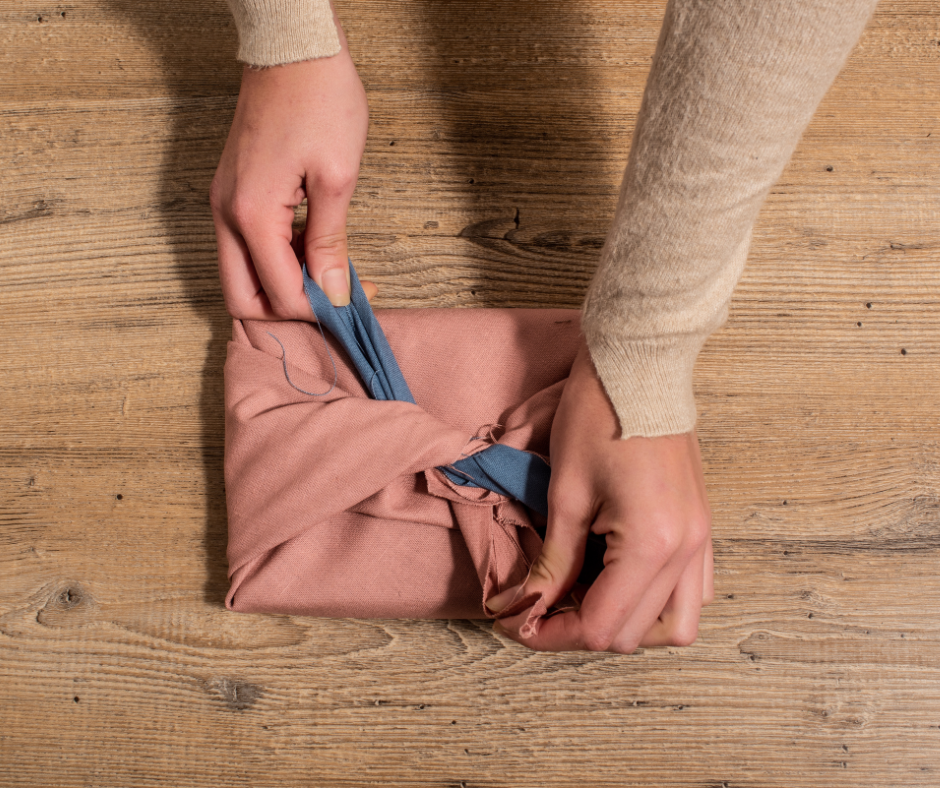

The adoption of Furoshiki as an alternative to traditional gift wrapping presents a tangible opportunity to reduce waste and resource consumption during the holiday season. Should this practice be embraced on a larger scale, the potential global impact in terms of waste reduction and sustainability could be substantial.
As we collectively strive for a more sustainable holiday season—integrating Furoshiki into our traditions can serve as a symbol of our commitment to environmental stewardship. Readers are encouraged to share their own experiences and methods for cultivating a greener holiday in the comments—fostering a community of shared knowledge and mutual inspiration towards this common goal.
2 Comments
Comments are closed.




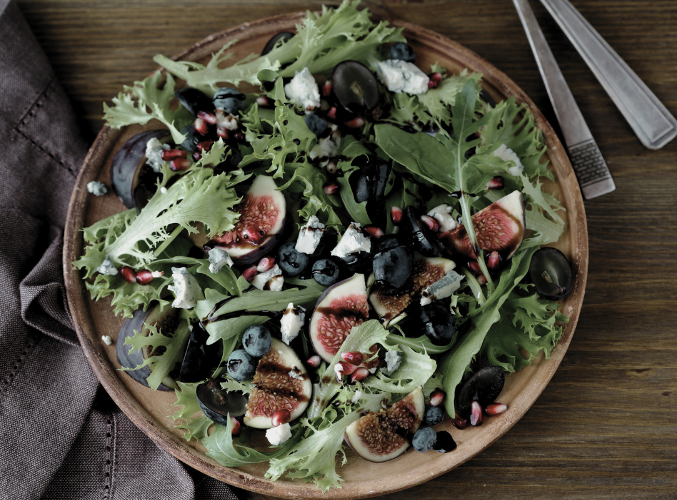




Jane Southgate
I love tour article. Would you be interested in sharing this as a guest blog on our website, linking back to your page?